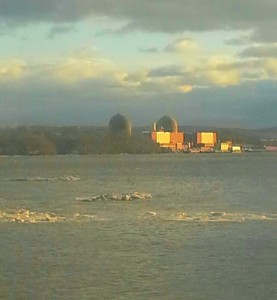TV news doesn’t hesitate to cover stories about threats to health and safety.
Stories on Ebola, Measles outbreaks, coyotes running wild in suburbia and even hazardous potholes are found in the news every day. The story of the Coyote Jihad in Chappaqua NY recently made international news for a few days. They often bump up the drama and threat levels evoking fear in viewers
There is a health and safety story in the NY metro area that has not received the media attention it truly deserves. The media is strangely silent on this one.
There is a 42″ high pressure fracked gas pipeline being planned for right next door to the aging Indian Point nuclear power plant. If it were to catch fire, the 40 years of radioactive waste, the thousands of gallons of diesel fuel and the reactors themselves could catch fire and cause a catastrophe of huge proportions.
Entergy, the corporation that owns the Indian Point nuke plant commissioned a study on safety and told the NRC (Nuclear Regulatory Commission) that it would be just fine and dandy. Their report said that having a huge high pressure gas pipeline so close to a nuke plant would not add significant risks.
There have been no independent studies on the risks of putting so much flammable, potentially explosive gas so close to a nuke plant. No where else in our entire country is there a situation like this.
Fires and explosions of high pressure gas pipelines are not uncommon. The magnitude of this threat is astronomical.
20 million people live within 50 miles of Indian Point, these 20 million would be directly impacted if the pipeline or the nuke plant were to catch fire. Incineration and widespread distribution of huge amounts of radioactivity would not be out of the question.
But the media would much rather tell you all about the kids with measles, the coyotes threatening the suburbs and the potholes swallowing cars.
One public official who lives within the blast zone of Indian Point is holding a press conference tomorrow. Will the media cover this press conference or this story? Stay tuned!
Here’s how you can help.
If you know anyone in the press who is a writer or TV producer, please send them the press release below and urge them to cover this story.
***PRESS CONFERENCE – FRIDAY, MARCH 20 at 2:30 p.m.***
Cortlandt Town Hall
1 Heady St.
Cortlandt, NY
Supervisor Linda Puglisi of Cortlandt and other elected officials will be speaking out in opposition to FERC’s issuance of a conditional Certificate for the Spectra AIM project. Nuclear expert Paul Blanch will talk about the about potential for a region-wide catastrophe if a rupture of the massive 42-inch gas pipeline were to occur just a few hundred feet from vital structures at Indian Point.
Why is this an emergency?
Last week , the Federal Energy Regulatory Commission (FERC) approved Spectra Energy’s Algonquin Incremental Market (AIM) project, including a 42-inch diameter high pressure gas pipeline slated within 105 feet of vital structures at the Indian Point nuclear power plant. This dangerous project must not be allowed to proceed! A critcal comprehensive, independent and transparent risk assessment of the AIM pipeline project next to the Indian Point nuclear power facility has not been conducted despite the continuous and strong demands by nuclear power and pipeline engineers and safety experts, medical disaster expert, public officials and thousands of residents in the New York tri-state area.
The approval of the AIM high pressure gas pipeline project is based on unverified assumptions by Spectra Energy, the pipeline company, and accepted by Entergy, the Indian Point nuclear power facility operator, and the Nuclear Regulatory Commission (NRC) that in the event of a pipeline failure or accident next to Indian Point, the pipelines valves could be remotely (from Texas) shut down in only 3 minutes. Independent nuclear power and pipeline safety experts indicate that the assumed 3 minute shutdown response time is considered “highly inappropriate and unrealistic for this 42″ diameter, high pressure pipeline and this sensitive infrastructure given substantial data of gas transmission pipeline ruptures generating high heat flux well past one hour.” This could result in loss of power to Indian Point, system failure or blockage of emergency access, lack of “failsafe” shutdown of Indian Point and loss of radiation storage containment that could result in a catastrophic radiation release in a densely populated region.




